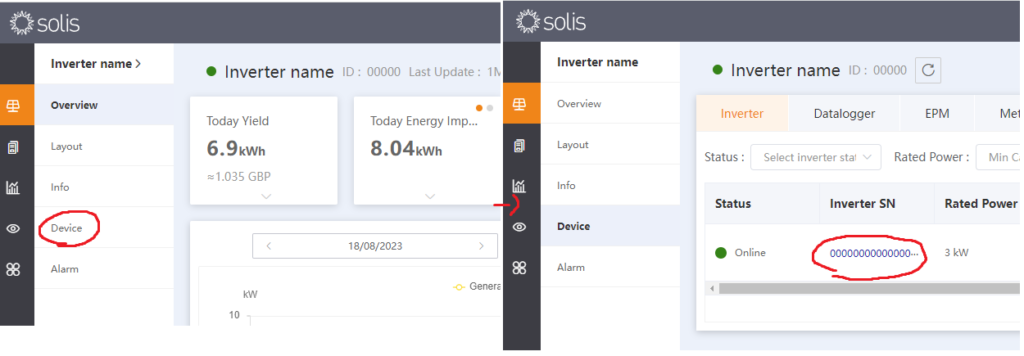Make use of Octopus Power-ups using a Solis Hybrid inverter.
Octopus energy recently announced they would be offering Power-ups; short periods of free electricity to customers in certain areas.
As one of the lucky people living in a Power-ups area, I wanted to quickly put together some basic notes on how to configure a Solis Hybrid Inverter to charge from the grid during these times. See https://octopus.energy/power-ups/ to find out more about the scheme.
Note: This is all just my personal thoughts. I’m not an expert and information may be inaccurate so listen to me at your own risk. If you are not comfortable changing these settings – don’t. I’m fairly sure you could break your install or worse by incorrectly changing settings within these menus.
While everything mentioned here can be managed directly on the Inverter, the steps below our done using the remote management tool on Solis Cloud. If you have not already, you will need to manually request access to this at https://solis-service.solisinverters.com/en/support/solutions/articles/44002373796-inverter-remote-control-application
Once approved, you will likely need to log in and out again to see the new buttons.
Setting the Inverter to charge from grid during the Power-up.
To start, enter the management console. From the plant overview screen select your plant (there should normally just be the one).
In the left hand menu you should then see a tab labelled “Device”, click this and you should see a list of inverts. Select the inverter serial number to view the Inverter itself

Then in the top right you should see the following buttons. Select “Inverter control”.

At this point you will need to re-enter your password and agree to the warning.

Now you should see a Control panel similar to the following.

To start select Work Mode, then select Self-consumption from the options avaiable.

You should then see a screen that looks like the below.

First, confirm self-use mode switch is on by clicking into Self-Use Mode Switch and confirming current value is “enable”.

Next enter Charge and Discharge.
Here I set charging current1 to 50Amp (the default), leaving discharge as 0 (as I don’t want to export). I also set the charging time as the period for the upcoming “Power up”. In my case 2pm till 4pm.
Unfortunately you can’t schedule this in advance so you’ll have to set this on the day, then turn it back off again afterwards or you risk it charging the battery on days when grid power is noticeably less free.

Now that is done, you can click in to Time of use switch and enable it. This pretty much just tells the inverter listen to the charging/discharging times you selected previously. These are ignored once this is turned back off.

Finally, select Allow Grid Charging, and enable it.

And then it is just a case of waiting for the “Power up” to start.
Assuming all is well your battery should begin to charge at around 2.5kW. This will first use any solar generation you have (as this goes direct to the battery), and then top’s up the rest from either spare power capacity in your home or the grid.
That said….
Please do remember to disable the “Time of use switch” and potentially “Allow grid charging” options after the power up is complete. If you forget you will end up paying for the grid import the next day when the defined charging slot comes around again.
A few more notes.
- Everything described here was tested on my own solar “plant”, a 3.4kW Solis Hybrid Inverter with 2 Us3000c PylonTech batteries.
- My home setup was previously in its default “self use” mode state after it’s installation.
I did find two particularly interesting things that were not originally clear to me when setting this up.
- While in self use mode, even with allow grid charging on – your system will not charge from the grid unless its during a charging period (configured in the charge and discharge settings).
- Better still – the charge from grid settings naming is slightly misleading. What it actually appears to mean is “Allow inverter to charge battery from an AC source”.
Why is this interesting?
Well, if you happen to have a second solar setup in your home (like I do from an older install), enabling this will actually allow your battery to charge using the spare AC capacity generated by the system, while not touching anything from the Grid itself. I’m fairly sure this only works due to my hybrid inverters CT clamp being on the main power from the house, allowing it to detect if there is spare capacity that’s currently being exported. I assume this is the standard approach, but best to confirm if you are unsure.
Its worth noting that the same configuration options could also be used to set a non “Power up” based charging schedule (given that is what they are actually intended for), for example if you get cheap power over night or similar. Given I don’t get that, the “Power up” was my first time touching any of these options. As such, I thought someone out there may find it useful to have this all written down, given the manual wasn’t quite as clear as I would have preferred
Thanks for reading.
That’s pretty much all there is to it.
Let me know if this was helpful or if I missed anything that’d be good to know.
